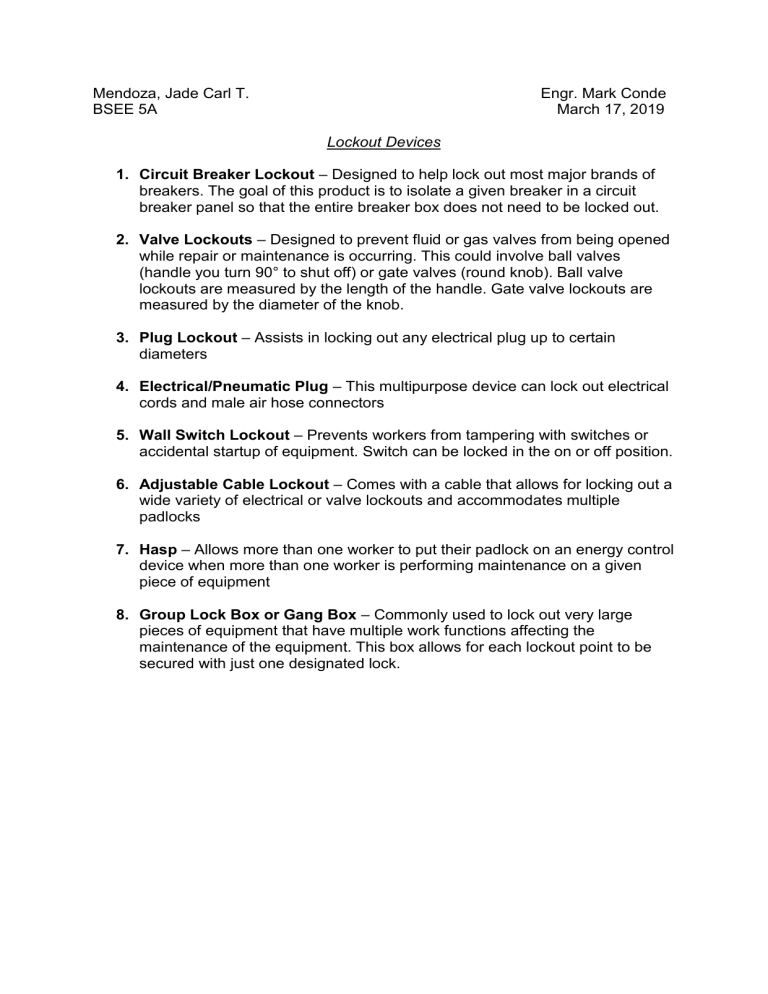
Mendoza, Jade Carl T. BSEE 5A Engr. Mark Conde March 17, 2019 Lockout Devices 1. Circuit Breaker Lockout – Designed to help lock out most major brands of breakers. The goal of this product is to isolate a given breaker in a circuit breaker panel so that the entire breaker box does not need to be locked out. 2. Valve Lockouts – Designed to prevent fluid or gas valves from being opened while repair or maintenance is occurring. This could involve ball valves (handle you turn 90° to shut off) or gate valves (round knob). Ball valve lockouts are measured by the length of the handle. Gate valve lockouts are measured by the diameter of the knob. 3. Plug Lockout – Assists in locking out any electrical plug up to certain diameters 4. Electrical/Pneumatic Plug – This multipurpose device can lock out electrical cords and male air hose connectors 5. Wall Switch Lockout – Prevents workers from tampering with switches or accidental startup of equipment. Switch can be locked in the on or off position. 6. Adjustable Cable Lockout – Comes with a cable that allows for locking out a wide variety of electrical or valve lockouts and accommodates multiple padlocks 7. Hasp – Allows more than one worker to put their padlock on an energy control device when more than one worker is performing maintenance on a given piece of equipment 8. Group Lock Box or Gang Box – Commonly used to lock out very large pieces of equipment that have multiple work functions affecting the maintenance of the equipment. This box allows for each lockout point to be secured with just one designated lock. Lockout / Tagout Procedure Step 1: Detailed procedures for equipment Begin by making sure you’ve identified the equipment correctly and accurately, including its specific location. Next, determine the correct procedure for shutting down and restarting the equipment. Detail that procedure, step by step, in writing. Consider all of the energy sources that may be connected to the equipment. Be very specific, because ambiguous language could lead to an incorrect or even dangerous action. Step 2: Notify affected employees When maintenance is going to be performed, all of the employees that may be affected should be notified. Let them know the timing of the work, and how long the equipment may be unavailable. If the unavailability of the equipment requires a change in work processes, be sure they are familiar with the steps to be taken. Step 3: Shut down equipment properly Explain the shutdown process in detail. It’s not enough to say something like “disconnect the machine.” To ensure everyone’s safety and reduce the potential for damage, the shutdown instructions should be detailed. Spell out the exact actions to be taken and the correct sequence for performing those actions. Step 4: Disconnect all primary energy sources Although this may seem fairly self-explanatory, once again, it’s important to be very detailed. Whether the primary energy sources include electricity, steam, water, gas, compressed air, or others, don’t assume that the person performing maintenance will know the correct procedure to follow. Again, explain exactly what needs to be done. Step 5: Address all secondary sources While disconnecting the primary energy sources may remove much of the potential danger, it’s possible that there sources of residual energy, such as trapped heat in a thermal system, fumes that may need to be vented, or even tension in a spring assembly. Identify the process that will relieve any remaining pressure or other energy. Also consider other hazards, such as moving equipment that must be secured before work begins. Step 6: Verify the lockout Once you’ve disconnected all primary and secondary sources of energy, attempt to start the equipment to verify that the lockout has been successful. Before you try to start it, verify that nobody is in a position where they could be hurt. Assuming that the procedures have been successful, return all switches and other equipment back to their “off” positions so the machine won’t start unexpectedly when the energy sources are reconnected. Once you’ve verified the lockout, attach a lockout or tagout device to the equipment to ensure that it cannot be started without removing the device. Step 7: Keep it in force during shift changes The equipment must remain in lockout/tagout condition across shift changes, so that workers arriving at the site are aware that the equipment is out of service. If individual locks or tags are used, the individual responsible for designating the lockout/tagout and the individual responsible for it during the next shift must both be present as the locks or tags are switched. Step 8: Bring the equipment back on line When the work is done and all tools and other materials have been removed, the machine can be brought back into operation. Here again, the procedure should spell out the exact steps that are involved, along with the correct sequence. For example, you may need to open a particular machine’s discharge valves before you open the inlet, so any unexpected water or steam remaining in the lines has a place to go.


